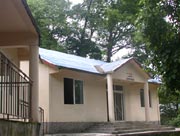|
 In the 1980s, scientific work conducted in the China Conservation and Research Center for Giant Panda focused mainly on the ecology, behavior, species group condition, and main diet bamboos of the giant panda. Through this research work, the center had access to the group number and distribution of giant pandas in the reserve; meanwhile, a lot of information has been acquired about the reproduction, physiology, and diet of the giant panda. Economic conditions of the local residents were also investigated and practical measures have been taken to increase their sense of nature conservation. As a result of the efforts taken, the number of giant pandas in the wild of the Wolong Natural reserve presents a tendency to increase. In the 1980s, scientific work conducted in the China Conservation and Research Center for Giant Panda focused mainly on the ecology, behavior, species group condition, and main diet bamboos of the giant panda. Through this research work, the center had access to the group number and distribution of giant pandas in the reserve; meanwhile, a lot of information has been acquired about the reproduction, physiology, and diet of the giant panda. Economic conditions of the local residents were also investigated and practical measures have been taken to increase their sense of nature conservation. As a result of the efforts taken, the number of giant pandas in the wild of the Wolong Natural reserve presents a tendency to increase.
In 1978, the first giant panda observation station in the wild was built to conduct ecological research on vertebrates in the reserve.
In 1978, the Wolong Natural Reserve signed a long-term cooperation agreement with WWF, and the May 1 Observation Station became an ecological observation and research base for the giant panda and its edible bamboos. Led by Dr. George Schaller, the first group of experts from WWF came to the May 1 Station. Together with Chinese experts led by Prof. Hu Jinchu, they did deep and comprehensive research on wild giant pandas, gnus, golden monkeys and other associate animals. In the four-year research, they have had access to the rarest first-hand materials that laid the basis for research on the giant panda in the world.
In 1982, WWF sent Dr Kliman, an expert on animal behavior, to Wolong. Cooperating with Chinese scientists, he conducted research on the reproduction behavior of manually-bred rare animals like giant pandas.
In 1982, WWF sent botanist Julian to the "May 1 Station" to do research on the main dietary bamboos of the giant panda together with Chinese experts led by Prof. Qin Zisheng.
From 1983 to 1985, Ken Jason, zoologist sent by WWF, came to the "May 1 Station" and conducted cooperative research with Chinese researchers on ecological situation and species population of the wild giant panda and other associate wild animals.
From 1984 to 1986, Dr. Alan Taylor, a botanist sent by WWF to the "May 1 Station," came to the "May 1 Station" and conducted cooperative research with the Chinese expert Qin Zisheng on the main dietary bamboos of the giant panda and vegetation in the Wolong Natural Reserve.
From 1984 to 1985, Dr. John Wright, a veterinarian sent by WWF, came to the giant panda research center. Cooperating with Chinese scientists, he conducted researches on the disease treatment, physiology and biochemistry, pathology and anatomy, and artificial reproduction of the manually-bred giant panda and other rare animals.
From 1985 to 1987, WWF sent Dr. Reed came to the "May 1 Station." Together with Chinese scientists, Reed studied wild giant pandas and other biological resources in the reserve.
From 1985 to 1988, the research center cooperated with WWF and did the second large-scale resource investigation on giant pandas and other rare animals.
From 1985 to 1988, sent by WWF, Andrew Laurie and John Mackinnon came to Wolong as technical counselor of Administration and Planning of Natural Reserves. He assisted in making Administration and Planning of Natural Reserves (An Outline), which became the model of Administration and Planning of the Natural Reserves in China.
From 1991 to 1993, WWF sent veterinarian Dr. Su Monk to the giant panda research center to be a counselor to Chinese veterinarians and administrators of the center.
Research Tasks and Achievement
Cooperation with American, Japanese and Other Foreign Institutions
|



